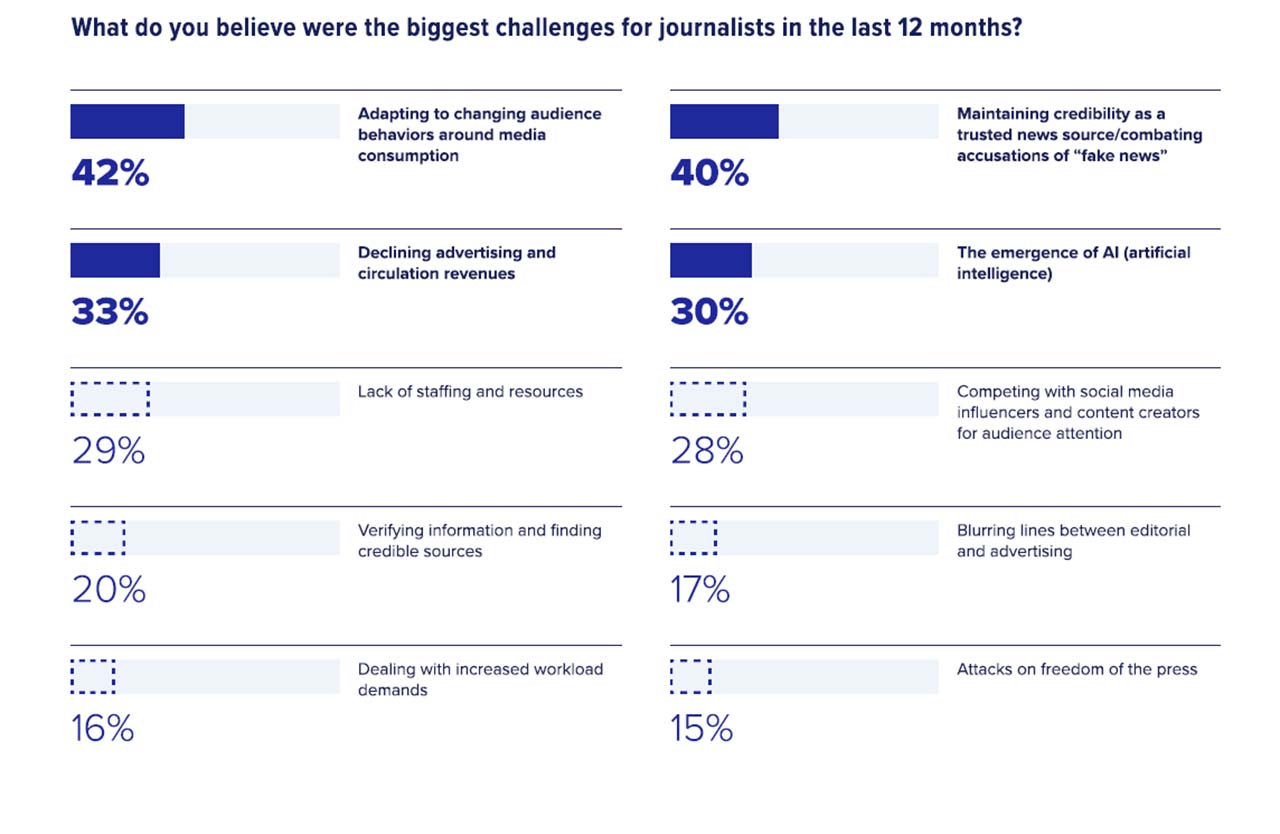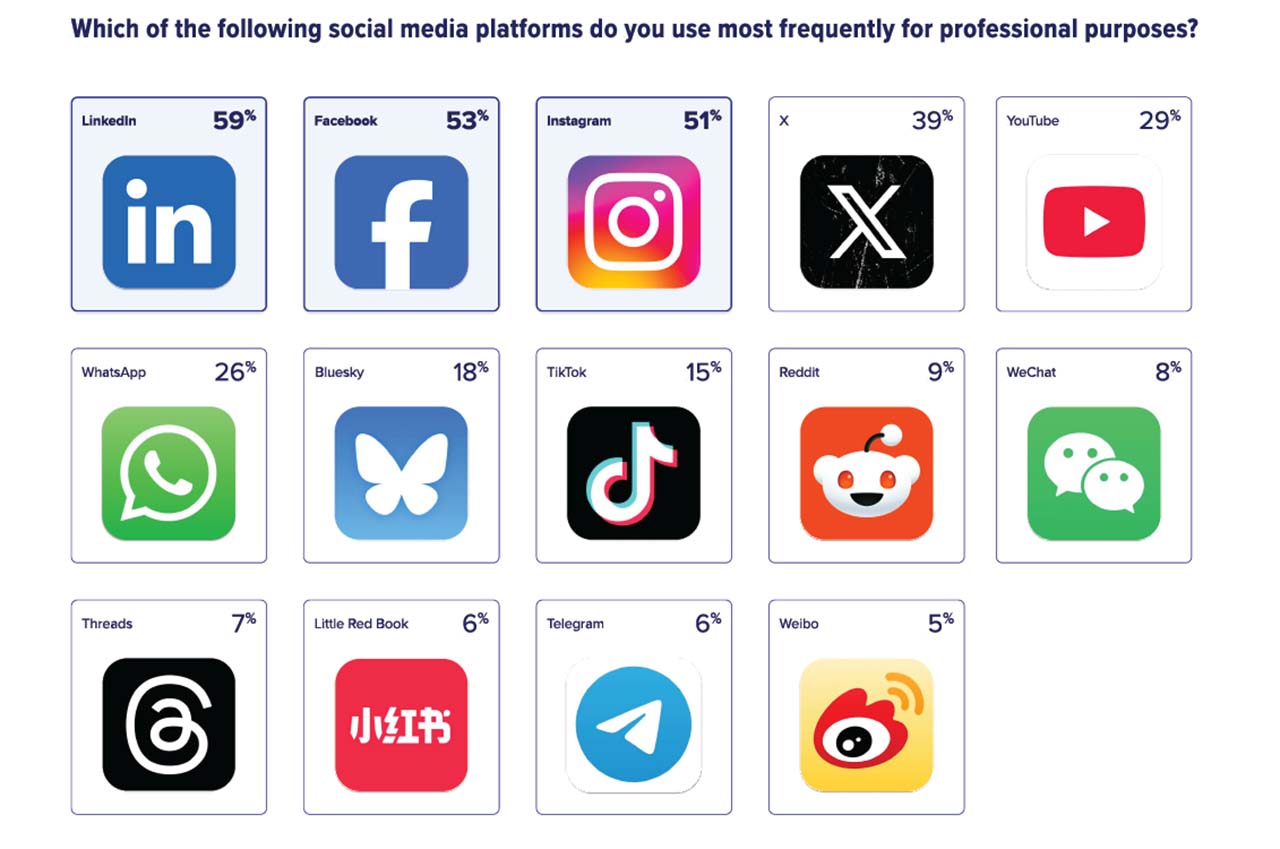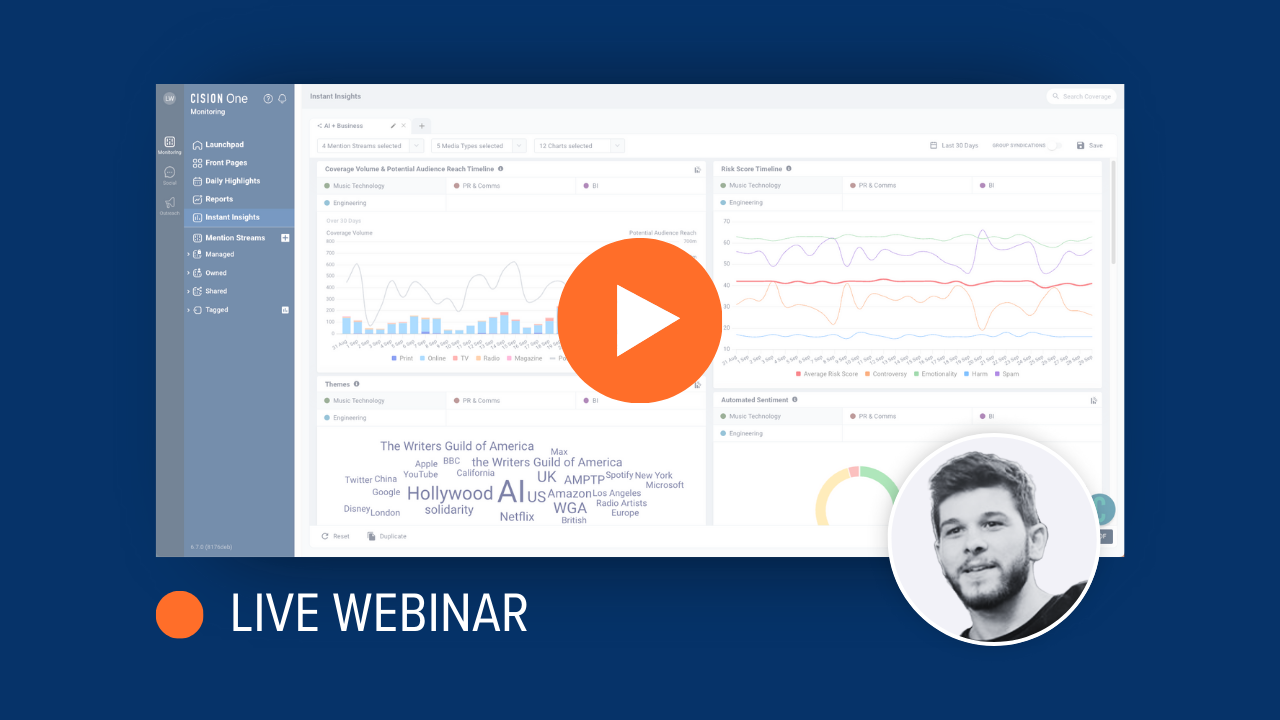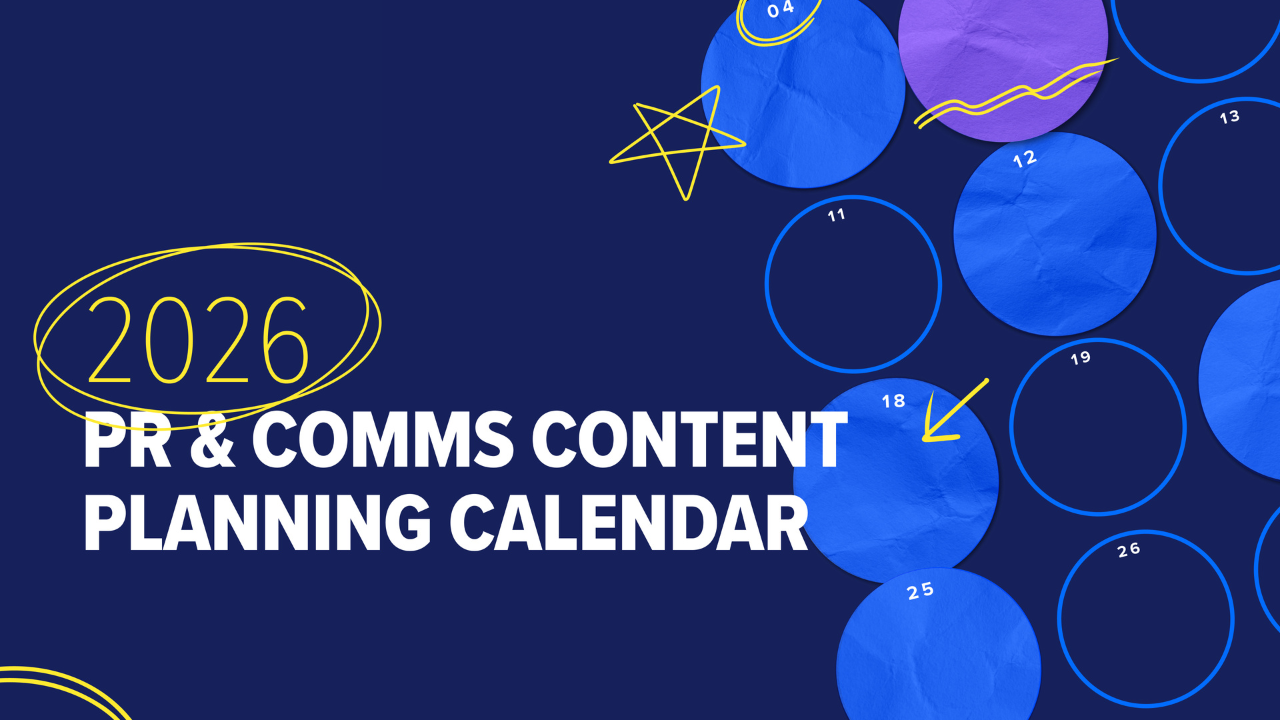The Cision State of the Media Report is now in its 16th year of delivering unmatched detail into how journalists work today. We surveyed more that 3,000 reporters from across the globe to understand how they feel about everything from the ongoing impact of artificial intelligence to shifting trends in social media.
The full 2025 report is available to download now, but if you’re looking for some fast takeaways – and relevant PR lessons – then we’ve brought together some of the topline findings.
1. Journalists Face Challenges Around Audience Behaviors
Leading this year as the biggest challenge for journalism is “adapting to changing audience behaviors around media consumption,” cited by 42% of journalists. Ranking second at 40% is “maintaining credibility as a trusted news source/combating accusations of ‘fake news’.”
These two challenges have switched places from last year, indicating that journalists are increasingly having to contend with a fragmented media landscape where audiences consume content across different platforms.
PR Lesson: Journalists are facing increasing challenges and are more strapped for time than ever. PR professionals have little power of this (and are probably experiencing many of these challenges themselves) but they can play a part as a valuable partner – e.g. by understanding the platforms reporters operate on and help them source the information they need to tell compelling stories.

2. AI Adoption and Application is on the Rise
The emergence of AI has left many in the media grappling with both its potential benefits as well as the negative impact it could have on their jobs. Though 30% of journalists named AI as a major challenge, more than half (53%) are using it to assist them in their work. For example, a quarter said they use it to research certain topics and 23% use it to transcribe interviews and audio.
When asked how they feel about PR pros using the technology, the majority say they are open to the idea, with only 27% indicating they are “strongly opposed.” Their biggest concern with PR professionals using AI is that the content will contain factual errors, cited by 72% of respondents.
PR Lesson: Transparency, accuracy, and human oversight remain essential when dealing with AI content. Creativity and authenticity lie at the heart of journalism – and many editorial staff have spent years developing subject matter knowledge. AI is not a direct replacement for human expertise, so tread carefully when supplying journalists with AI content. Make sure anything you send to them has been checked and verified by human eyes first.
3. Press Releases Still Matter
Despite how dramatically the media landscape has changed in recent years, the press release is still a crucial piece of content for most journalists. It’s consistently topped the list of content journalists most want to receive from PR pros, and 2025 is no different. This year, 72% of reporters named press releases as the most useful resource PR teams can offer. Furthermore, 79% said they rely on them to generate story ideas.
PR Lesson: Don’t sit back and wait for journalists to come across your press release on the wire – include a link to it in your email pitch (or copy and paste it at the bottom), and pair it with other elements that journalists explicitly want (according to our research. Multimedia, for example, can help journalists bring a story to life, and most journalists used PR-provided multimedia elements in their coverage last year, highlighting its utility. Offering an exclusive (wanted by 57% of reporters), or original research (55% of journalists said they wanted this from PR contacts), can significantly increase your chances of securing coverage as well.
4. Social Media Is Increasingly Fragmented
Ninety-six percent of journalists we surveyed say they use social media for professional purposes, largely to publish or promote their own work. However, with more platforms to contend with, that adds another level of complexity in understanding where journalists (and their audiences) are spending their time and energy. There are three social platforms where more than 50% of journalists say they use professionally:
- LinkedIn – 59%
- Facebook – 53%
- Instagram – 51%
Then there are newer platforms making an impression across different regions. WhatsApp, for example, is more popular in EMEA and APAC than in North America, while North American journalists are adopting Bluesky a lot more than their European and APAC counterparts.

In terms of how journalists use social media, 64% said they utilize it to publish and promote content, 55% to interact with their audience, and 51% to crowdsource information for stories.
PR Lesson: Armed with this knowledge around social media platform and usage preference, PR professionals can use this insight to their advantage. It provides a window into how journalists work, what they cover, and what kind of content they choose to share or amplify on social media. A good social listening platform can help here, too.
5. When Pitching, Think Quality Not Quantity
Though the ideal length of a pitch will often be dictated by its complexity, for most journalists it’s a case of the shorter the better. Twenty-eight percent said they’d prefer 100-200 words, while 17% said 200-300 words. A mere 2% wanted pitches that were more than 400 words, so keep an eye on your word count and don't stray into mini-essay territory.
Once your pitch is out the door, what’s next? It’s tempting to chase for a response, but the majority of journalists (62%) said that just one pitch follow up is appropriate. Beyond that, there's a risk of being blocked.
PR Lesson: Focus on honing your pitching skills. Keep things punchy and concise, and ensure you package up the pitch with supplementary content like images (wanted to 70% of journalists) or compelling data or statistics. If your pitch is running long, consider using AI to hone it to the saliant points – but make sure the output is fully vetted and refined by a human eye before hitting send.
6. “Relevance” is the Magic Word for Media Outreach
A consistent theme that emerged throughout the survey was “relevance.” Not only do PR professionals provide the most value when they connect journalists to relevant sources, but most journalists also say that pitching new, relevant story ideas can be instrumental in building relationships with them. Further, a significant 86% of journalists say they will reject a pitch because the outreach lacks relevance to their audience or beat.
PR Lesson: It’s crucial to do your research before reaching out to a media partner to ensure the story you’re pitching is right for their audience or beat, but you should also provide them with something they want and need – 54% of reporters said their ideal pitch should include compelling data or statistics, while 49% wanted a unique story angle.
7. How to Put the “R” Back in Public Relations
Journalists are so inundated with pitches and requests that making a connection might seem like an uphill task, but it is possible – and as our study found, most journalists are open to building relationships with PR professionals. (It just takes the right approach.)
The overwhelming majority of journalists (85%) said the best way to start building a relationship with them is simple: Introduce yourself via email, even without a story to pitch, and explain why you want to connect.
PR Lesson: PR and journalism are both so fast-paced, it can be easy to get caught up in transactional and one-off interactions. If you can invest time in getting to know journalists as humans and building relationships with them, it can lead to bigger benefits down the line.
8. Journalists’ Needs and Challenges Differ Globally
There is no one-size-fits-all approach for every reporter - and where they are located plays a big part in that. Journalists around the world differ when it comes to the challenges they face, the way they work, and what they want from media relations teams.
In some cases, the variations in how journalists across North America, EMEA, and APAC countries work is stark. For example, AI adoption in APAC is high, with 41% saying they use it to help create outlines or early drafts of content (compared with just 11% in North America).
PR Lesson: Understanding journalists on an individual level, what matters to them and their audience, and how they view public relations is more important than ever. This should be a key consideration for PR teams working with international clients. It’s important to think both locally and globally, and construct media lists to fit your region-specific pitches. CisionOne Outreach and its global, validated database can help here.
Final Thoughts
These findings from the 2025 State of the Media Report highlight a clear message: success relies on understanding journalists' evolving needs. As the media changes and new challenges arise, PR teams need to ensure they're providing journalists with relevant stories backed by compelling data. Building authentic relationships requires thoughtfulness and personalization in your outreach.
While technology and platforms may change, the fundamentals of public relations remain constant – journalists want trustworthy partners who can provide valuable, audience-relevant content.
For more findings and analysis on what these numbers mean for your strategy, download the full SOTM report.
Find out how CisionOne can help you connect you with the right journalists to share your stories, speak to one of our experts.
Most Recent Posts
Cision Resources
-
E-books and Guides
Comprehensive how-to guides on strategy and tactics
-
Case Studies
What are other brands doing – and how can we learn from them?
About Simon Reynolds
Simon is the Senior Content Marketing Manager at Cision. He worked as a journalist for more than a decade, writing on staff and freelance for Hearst, Dennis, Future and Autovia titles before joining Cision in 2022.
Learn More. Do More. demo new
PR Tips, Case Studies, and Product Updates

[On-Demand Webinar] The Next Generation of Media Intelligence: From Gorkana to CisionOne
Explore CisionOne, a revolutionary media intelligence platform, and the evolution of Gorkana. Learn key features and strategies from Luke Williams, CisionOne Product Marketing Manager. Elevate your media outreach to new heights!


